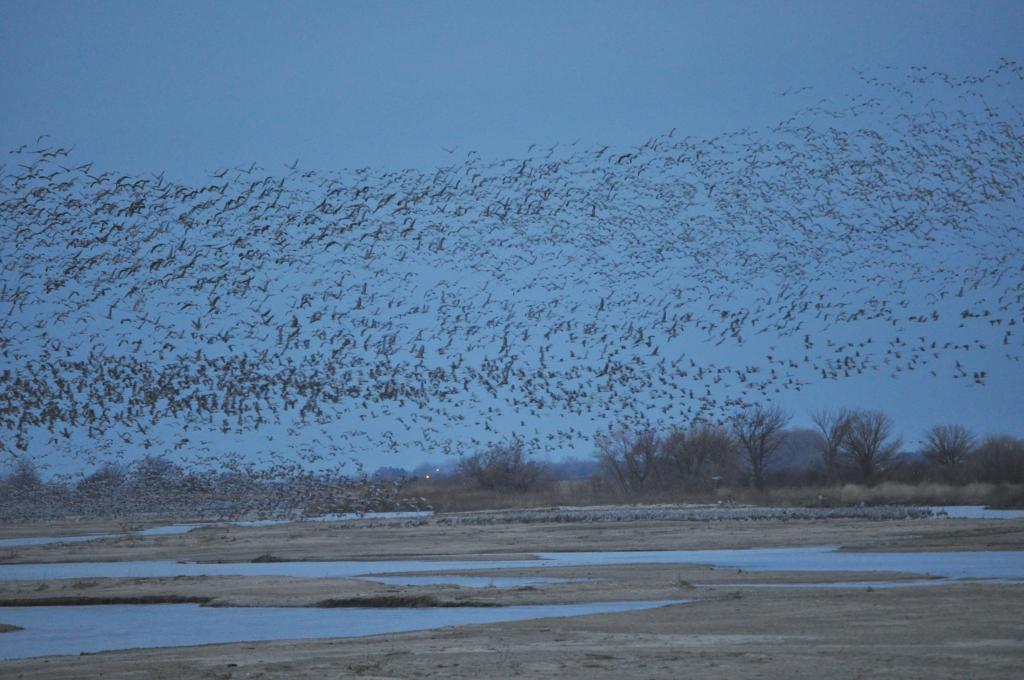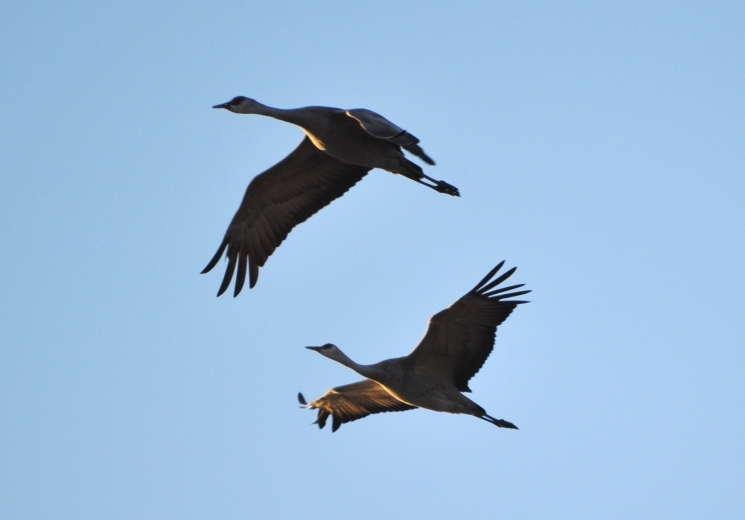It’s February and the snow is almost spilling over the deck railing outside my window. My Florida friends are posting pictures of palm trees with snotty remarks about how they don’t need no stinking groundhogs, while my northern friends are unleashing a torrent of complaints as unrelenting and bitter as the cold.
So I’m going to tell you to go where in March? Florida? Hawaii? The Caribbean? All good choices, but how about Nebraska?
Yes, south-central Nebraska in March, where the temperatures may be in teens (or lower). Even more, I’m going to tell you to bring your warmest clothes, because you’ll be standing outside for a few hours — oh, at 5:30 in the morning.

Here’s what caught my attention last year: I read an article that said that none other than Jane Goodall considered the annual Nebraska sandhill crane migration to be one of the world’s great wildlife spectacles. I figured Jane Goodall knows a thing or two about wildlife. So I went.
According to the Rowe Sanctuary, an Audubon facility in Gibbon, Nebraska, more than 10 million migrating birds fly north over south-central Nebraska’s Platte River every spring. The migration, which centers around the cities of Kearney and Grand Island, includes 400 species, including snow geese, hooded mergansers , the (occasional) rare and endangered whooping crane — and more than half a million sandhill cranes. The cranes winter in Texas, New Mexico and Arizona and summer in Canada’s Hudson Bay and central Alaska. A few adventurous souls even cross the Bearing Straight into Russia. And in the fall they turn around and do it all backwards. Each time, they stop here feed and rest up for the remainder of their journey.
The Platte River: A Mile Wide and an Inch Deep
Settlers heading west on the Oregon Trail described the Platte River as a mile wide and an inch deep. That makes it hell to navigate in a wagon, but it’s ideal for sandhill cranes, who like to sleep standing up in water so they can hear the splashing and dripping of any predators. Indeed, the region is so vital to birds that it has been designated an Important Bird Area of global significance.

Today’s Platte is not nearly as wide as the Platte that frustrated the settlers, although organizations such as the Audubon Society are working to preserve as much of it in as natural a state as possible. But in central Nebraska, it is still braided and shallow enough to provide the cranes with their preferred nocturnal habitat. The surrounding dormant corn fields, filled with last year’s dropped kernels, make it the avian equivalent of an all-you-can-eat buffet.
Prime time for seeing the migration is dawn and dusk, as the cranes depart from and return to their sleeping quarters in the Platte River. So by 5:30 I’m on my way to see the sunrise at the Rowe Center, an Audubon facility that operates a series of bird-watching blinds and offers guided tours with naturalists during the migration.
It’s in the low teens when I arrive. We get a brief orientation. First rule: Silence is golden. We don’t want to startle the birds into rising in a panicked flock and possibly decapitating themselves on the electric lines that run near and across the river. Cells phones are muted, camera flashes are turned off, and, armed with flashlights pointed at the ground, we quietly walk to the blinds, which provide breaks from the wind, if not the temperature.
 The dawn air is taut and crackling sharp. It’s not exactly quiet – – there’s an ongoing murmuring, a companionable sort of conversation of squawks and hoots. Cranes are verbal birds with strong family bonds; they recognize each other by their calls, and they seem to have a lot to say. Mom, pop, and kids sleep in nuclear family groups. As the night slowly lifts, shapes emerge from the gloom, and the squawking gets louder. First one family, and then another, takes to the skies. The commotion wakes others, and bigger and bigger groups leave, noisily now, heading out for a day of binging on corn.
The dawn air is taut and crackling sharp. It’s not exactly quiet – – there’s an ongoing murmuring, a companionable sort of conversation of squawks and hoots. Cranes are verbal birds with strong family bonds; they recognize each other by their calls, and they seem to have a lot to say. Mom, pop, and kids sleep in nuclear family groups. As the night slowly lifts, shapes emerge from the gloom, and the squawking gets louder. First one family, and then another, takes to the skies. The commotion wakes others, and bigger and bigger groups leave, noisily now, heading out for a day of binging on corn.
In the evening, the process reverses. This time, I’m at the Crane Trust Nature and Visitor Center in Alda. Like the Rowe Sanctuary, the Crane Trust offers educational programs and blinds in which to hide.
Getting to the blind just before sunset, I stare at a deserted stretch of river. A few small groups of cranes swoop in, and land in the ice-cold water, choosing a spot to call home for the night. A few more groups, bigger now, arrive. And then, with the force of a locomotive, a thundering cacophony shatters the stillness of the evening. Thousands, tens of thousands, of birds arrive in a chorus of urgent calls to mates, friends, families. They darken the sky, they swarm in to land, they fuss and bustle and jostle, and the river fills up, and the light fades, and still more and more and more birds keep coming. For almost two hours, stragglers continue to arrive.
But finally, with the light gone, the birds seem to be all in for the night. The squawks are muted now, and the black shapes of the birds all but dissolve into the black ink of the river.
I turn to leave, quietly, like leaving a sleeping child. As I walk back to the center, it occurs to me that people on the coasts call the Midwest, the fly-over states. They have no idea how right they are.

